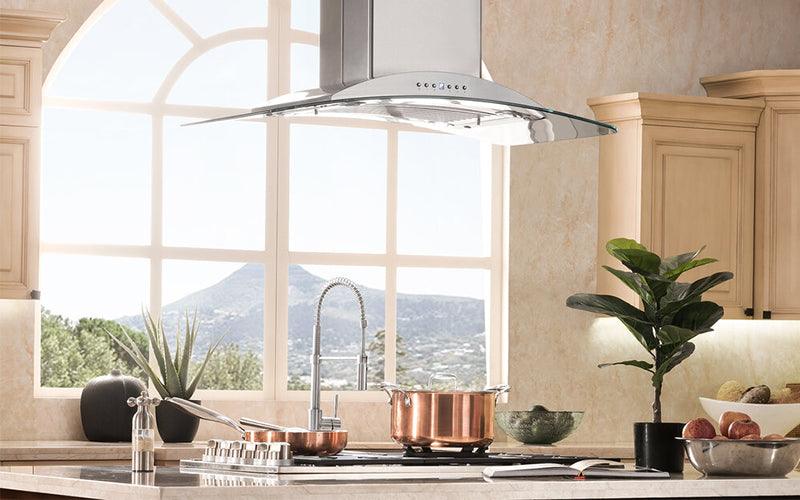Wall-mounted kitchen hoods, also known as range hoods, are an essential appliance for modern kitchens. They not only enhance the aesthetics of the space but also play a vital role in maintaining a clean and healthy environment. In this blog post, we will delve into the various features of wall-mounted kitchen hoods, highlighting their functionality and benefits.
-
Design and Aesthetics: Wall-mounted kitchen hoods come in a wide range of designs, materials, and finishes, allowing you to choose the one that complements your kitchen decor. From sleek stainless steel to elegant glass and bold designs, these hoods add a touch of style to your cooking space while effectively performing their primary function.
-
Ventilation Power: One of the primary features of wall-mounted kitchen hoods is their ventilation power. These hoods are equipped with powerful fans and motors that efficiently capture and extract smoke, steam, grease, and odors from the cooking area. The ventilation power is measured in cubic feet per minute (CFM), and higher CFM ratings indicate better airflow and faster smoke extraction.
-
Extraction Methods: Wall-mounted kitchen hoods offer different extraction methods to cater to individual needs. The most common types include:
a) Ducted Hoods: These hoods expel the extracted air to the outside through a duct system. Ducted hoods are highly efficient in removing pollutants and are suitable for kitchens where ductwork is feasible.
b) Ductless Hoods: Ductless hoods use filters to trap airborne particles and then recirculate the filtered air back into the kitchen. These hoods are ideal for kitchens without external ventilation options or where ductwork is impractical.
-
Fan Speed and Control: Wall-mounted kitchen hoods typically come with multiple fan speed settings, allowing you to adjust the airflow according to your cooking requirements. Higher fan speeds are ideal for heavy cooking or when excessive smoke and odors are present, while lower speeds offer quieter operation during lighter cooking tasks.
-
Lighting: Many wall-mounted kitchen hoods feature built-in lighting options to illuminate the cooking area. These lights can provide enhanced visibility, making it easier to monitor food and ensure optimal cooking results. Common lighting options include LED lights, which are energy-efficient and provide bright illumination.
-
Filters: Filters play a crucial role in capturing and removing grease, smoke particles, and odors from the air. Wall-mounted kitchen hoods are equipped with various types of filters, such as:
a) Mesh Filters: These metal filters are made of multiple layers of aluminum or stainless steel mesh. They effectively trap grease and are easily removable and dishwasher safe.
b) Charcoal Filters: Charcoal filters are used in ductless hoods and are designed to remove odors and impurities from the recirculated air. These filters need regular replacement to maintain optimal performance.
-
Noise Reduction: Noise levels can be a concern when it comes to kitchen hoods. Many wall-mounted hoods incorporate noise reduction features, such as insulated motor housings and sound-absorbing materials, to minimize operational noise. This ensures a quieter cooking experience without compromising on performance.
Disadvantages of Wall-Mounted Smoke Extractors:
-
Limited Placement Options: Wall-mounted range hoods require installation on a wall, which limits their placement options. If your kitchen layout doesn't have a suitable wall space above the cooking area, installing a wall-mounted extractor may not be feasible or may require significant modifications.
-
Installation Complexity: Installing a wall-mounted smoke extractor typically requires professional assistance. It involves proper mounting, electrical connections, and venting to ensure optimal performance. The installation process can be complex and may involve additional costs for hiring a qualified technician.
-
Maintenance and Cleaning: Like any other type of range hood, wall-mounted smoke extractors require regular maintenance and cleaning. The filters need to be cleaned or replaced periodically to maintain optimal performance. Depending on the model, cleaning the hood and accessing the filters may require some effort and time.
Conclusion: Wall-mounted kitchen hoods offer a range of features that contribute to efficient and effective ventilation while adding style to your kitchen. From their design and ventilation power to extraction methods, fan speed control, lighting, filters, and noise reduction, these hoods provide a comprehensive solution for maintaining a clean, odor-free, and comfortable cooking environment. Consider the features that align with your specific needs and preferences to choose a wall-mounted kitchen hood that enhances both functionality and aesthetics in your culinary space.





Leave a comment
All comments are moderated before being published.
This site is protected by hCaptcha and the hCaptcha Privacy Policy and Terms of Service apply.